 Under the Bankruptcy Code, non-residential real estate gets special treatment. Pursuant to Sections 362(b)(10), 365(c)(3), 365(d)(4)(A) and 541(b)(2) of the Bankruptcy Code, if real estate is deemed “nonresidential” in nature, a lease of such property terminated prepetition (1) is not estate property, (2) may not be assumed, and (3) is not subject to the automatic stay. The specific Code sections respectively provide:
Under the Bankruptcy Code, non-residential real estate gets special treatment. Pursuant to Sections 362(b)(10), 365(c)(3), 365(d)(4)(A) and 541(b)(2) of the Bankruptcy Code, if real estate is deemed “nonresidential” in nature, a lease of such property terminated prepetition (1) is not estate property, (2) may not be assumed, and (3) is not subject to the automatic stay. The specific Code sections respectively provide:
Section 362(b): The filing of a petition under section 301 … does not operate as a stay—
(10) … of any act by a lessor to the debtor under a lease of nonresidential real property that has terminated by the expiration of the stated term of the lease before the commencement of … a case under this title to obtain possession of such property ….
* * * *
Section 365(c): The trustee may not assume or assign any executory contract or unexpired lease of the debtor, whether or not such contract or lease prohibits or restricts assignment of rights or delegation of duties, if—
(3) such lease is nonresidential real property and has been terminated under applicable nonbankruptcy law prior to the order for relief.
* * * *
Section 365(d)(4)(A) Subject to subparagraph (B), an unexpired lease of nonresidential real property under which the debtor is the lessee shall be deemed rejected, and the trustee shall immediately surrender that nonresidential real property to the lessor, if the trustee does not assume or reject the unexpired lease by the earlier of …
* * * *
Section 541(b) Property of the estate does not include—
(2) any interest of the debtor as a lessee under a lease of nonresidential real property that has terminated at the expiration of the stated term of such lease before the commencement of the case under this title ….
Despite repeated use of the term, the Code does not define the term ‘nonresidential.’ This has resulted in a split among the courts as to how ‘nonresidential’ should be defined. The majority approach examines the nature of the property leased (the “property test”). The minority position assesses instead the nature of the lease itself. Under the nature-of-the-property test, the court focuses on whether people reside at the leased location. See, In re Independence Village, Inc., 52 B.R. 715 (Bankr.E.D.Mich.1985) (concluding that a life-care facility for senior citizens was residential because people lived on the property); Matter of Terrace Apts. Ltd., 107 B.R. 382 (Bank.N.D.Ga.1989) (concluding that nature of the property is the key factor in determining whether a property is residential); In re Care Givers, Inc., 113 B.R. 263 (Bankr.N.D.Tex.1989) (concluding that although a nursing home had both a residential and nonresidential aspect, it was still considered residential);In re Texas Health Enters., Inc., 255 B.R. 181 (Bankr.E.D.Tex.2000) (concluding that nursing home leases were residential leases); and Alegre v. Michael H. Clement Corp. (In re Michael H. Clement Corp.), 446 B.R. 394 (N.D.Cal.2011) (applying nature of the property test, which the court believed was the majority view, to determine that property was residential). According to In re Passage Midland Meadows Operations, LLC, 578 B.R. 367 (Bankr.S.D.W.Va.2017), several reasons underlie the property test. Foremost, the courts rely upon the structure of the statutory language, suggesting “Congress was concerned with the type of property involved” For example, in §365(d)(4), the modifier ‘nonresidential’ directly qualifies the term ‘real property’. Therefore, purely as a matter of grammatical construction, ‘nonresidential’ refers to the nature of the property and not the type of lease. Passage noted however, that the property test analysis risked contravening “a time-honored principle of statutory construction,” namely, that a reviewing court must give meaning and effect to every word of the statute. Id. at 378. The court noted that “[i]f one broadens the analysis from the three words emphasized by the property test, it may help surface an entirely different statutory meaning.” Id. at 379.
Passage adopted the nature-of-the-lease test, which focuses on whether the intent of the lease is to provide income for the commercial lessee. See, In re Condo. Admin. Servs., Inc., 55 B.R. 792 (Bankr.M.D.Fla.1985) (concluding a mobile home park lease was nonresidential based on the nature of the lease and not on the use of the property as a residence); In re Sonora Convalescent Hosp., Inc., 69 B.R. 134 (Bankr.E.D.Cal.1986) (noting the commercial intent of the lease is used to determine that property was nonresidential even though patients resided on the property); In re Emory Properties, Ltd., 106 B.R. 318 (Bankr.N.D.Ga.1989) (concluding that a hotel lease was nonresidential based on commercial purpose and common meaning of the term “residential” even though it had permanent residents); and In re Clinton Care Ctr., LLC, 436 B.R. 390 (Bankr.N.D.Miss.2010) (concluding that §365(d)(3) applies to nursing home leases). The Passage court argued that the language of the statutes at issue required this outcome:
The [provisions which] focus on the (1) “lease of the debtor” (365(c)(3)), (2) the debtor as “lessee” (365(d)(4)(A)), (3) the “interest of the debtor” under the lease ((541(b)(2)), and (4) the lease “by … lessor to the debtor” (362(b)(10)) indicate together that one cannot so easily dispense with the actual use to which the debtor will put the demised premises personally while still giving effect to the entirety of the language used in the statutory provisions. The substance of the lease, namely the precise purpose the lessee has for the property, must find its way into the analysis.
And therein lies the difficulty with the property test. All would appear to agree in the cases applying the property test that the debtor lessees in question never had any intention of making the leased premises his, her or, its residence. And yet that salient fact is sidelined by the property test analysis in favor of focusing, instead, and in isolation, on the use to which unnamed, unknown nondebtor sublessees, perhaps far down the leasing chain, will put the property. And that remote use (e.g., living in a dwelling) will not be the same use (e.g., investment and income production) that the original leasing parties contemplated.
Id. at 379.
The court also stated that the “property test” leads to unnecessary complexities and unintended results, quoting Jeffrey S. Battershall, Commercial Leases and Section 365 of the Bankruptcy Code, 64 Am. Bankr. L.J. 329, 341 (1990)
The approach … of looking to the character of the property as opposed to that of the lease seems to offer less guidance in close cases, for example a residential apartment building which also has a number of commercial businesses or offices in the building. Opinions addressing such mixed character properties have drawn inconsistent conclusions. Looking to the character of the property in such mixed cases seems undeterminative as it is both residential and commercial in nature. One bankruptcy scholar has suggested that this sort of problem could be resolved by using some theory of “dominant use” but did not elaborate on how such dominant use would be measured. Either looking to the character of the property or its dominant use is arguably undesirable in that both approaches leave lessors and lessees without any clear guide regarding whether a lease in a mixed situation is residential or nonresidential prior to a specific court determination and thus with no means of knowing their specific rights and obligations under section 365. Alternatively, the method of looking to the character of the lease and the intent of the parties, … seems to provide better guidance for all parties, including the court, in a close situation. In the apartment building example, under this approach, the owner’s lease to the management company would be nonresidential or commercial as would the management company’s lease of space to commercial businesses in the building. The management company’s lease with tenants who live in the building would be considered residential.
Matthew T. Gensburg
[email protected]

